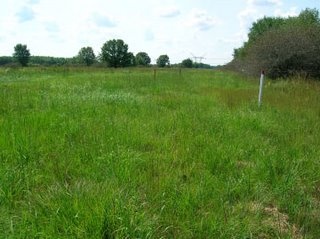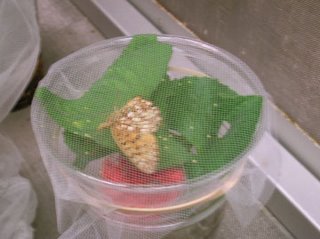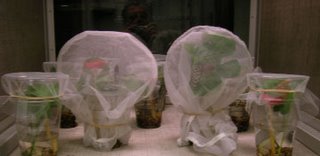I Am the Egg Man
Ur-Spo recently posted an entry that made a really cool reference to the Beatles’ I Am the Walrus. Since eggs have figured prominently in my life of late, I thought I’d continue the idea here. It’s been quite a week, which is why my postings have been so thin.

Commonwealth Edison Prairie
Last Thursday, a member of my staff accompanied me to Commonwealth Edison Prairie in Grundy County. Our goal was to collect silver-bordered fritillaries to use in some restoration activities. I was apprehensive because we have had difficulties with this species this year. I had been out to the site three other times and not found any. This time we found a whole bunch. Even more fortunately, we usually have to catch 20 or 30 males before we get a single female. Of the first nine butterflies that we caught, five were females. Given that we wanted five females, we were able to complete our work very quickly and head back home.
When we got back to the lab, we began setting the butterflies up in egg laying cages. To my delight, the first butterflies that we set up began laying eggs even before the last of the butterflies were in the cages. These cages are made from plastic drinking tumblers and netting. I've gotten used to going into JoAnne Fabrics and asking to be directed to the bridal section. Bridal veil fabric makes perfect netting for these cages. The female butterfly goes into the cage along with a pad soaked in some sugar water and a few sprigs of the host plant. If all goes well, the butterfly lays eggs all over the cage, mostly on the netting. As of this morning, we have about 700 silver-bordered fritillary eggs. The first of them began hatching yesterday.

Silver-bordered fritillary laying eggs. The eggs are the light objects on the netting at the top of the cage.
Last Friday, I ventured a bit further afield to a huge site near Kankakee, Illinois. Our quarry there was the elusive and beautiful regal fritillary. This butterfly has inexplicably disappeared from most of its range east of the Mississippi River since the mid 1970s. It formerly ranged all the way to the east coast and was reasonably common. We now have 5 females and about 300 eggs. This is exciting because the regal fritillary is very much a prairie butterfly here in Illinois. It’s also considered something of a poster child for invertebrate conservation in North America. We have been also been working with a close relative, the Aphrodite. I wrote a couple of weeks ago about getting Aphrodites from the Nachusa Grasslands near Dixon Illinois. We found more of them near where we found the regals, and I took another female for good measure. She turned out to be extremely fecund and produced nearly 200 eggs. Our total count off Aphrodite eggs is now about 450.

Near the Kankakee River
So what are we going to do with all of this eggy goodness? The eggs will all be hatching within the next week or two. The silver-bordered fritillaries are the most different of the bunch. They typically have 3 to 4 generations annually. The September generation is usually the biggest, but there is also fairly often a generation in October. Assuming we get pupae fairly early in October (and depending on the weather) we will be releasing silver-bordered fritillaries in McHenry County, Illinois in an attempt to start a new population there.

Eggy goodness
The regal and Aphrodite fritillaries are more closely related to each other than either is to the silver-bordered. They are both in the same genus (Speyeria). They share a curious life history. They have a single generation annually. Their eggs hatch in late September of early October. The newborn larvae eat the eggshells- then they stop eating and go directly into hibernation. They will complete their development in the spring. We have enough larvae from the Aphrodite to do some experimentation. We plan to place most of them in outdoor cold-storage cages for the winter (we’ll do the same with the Regal eggs). Come spring, we will retrieve them and continue the rearing process and release adults next June. The Aphrodites will go to a site in McHenry County. The regals will probably go to a beautiful prairie near Markham, where they used to be found. With some of the Aphrodites, we will attempt a mid-winter generation. The advantage to doing this is that it may be possible to use such an approach to augment the number of individuals that one can place out into the field.
Labels: Butterflies, Conservation


7 Comments:
It's nice to see we've found a good use for bridal veil material. ;)
The Regal Fritillary certainly lives up to it's name. What a beautiful butterfly!
Whee, look who's here. That picture of you really needs a pith helmet, though.
Hi Gary,
Thanks for stopping by. Nice picture of you. Is your companion Archy, Asher, or Tess?
That's Asher, taken a while back, probably winter of 1999/2000.
Although I belong to a couple of group blogs here on blogspot.com, and hence have an identity here, I find it cumbersome and am particularly disappointed in the notification capabilities (if indeed it has any at all.)
You'll find my daily scribbles over on LiveJournal instead. I'm bookmarking you here so I can find you easily.
Thanks, I've linked to you.
So I see. ;p Hope your readers aren't too easily distracted by fursuits and booktalk.
Post a Comment
<< Home